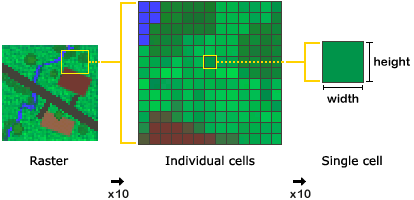Available with Spatial Analyst license.
When using the ArcGIS Spatial Analyst extension for your processing, you will have to use or create raster datasets. A raster is composed of an array of equally sized cells arranged in rows and columns, where each cell contains a value representing information such as elevation, temperature, or land-cover type.
It is important to understand how a raster dataset is represented in ArcGIS and the issues you need to be aware of when using and creating rasters. To get the maximum benefit of the capabilities of Spatial Analyst, you should be familiar with some fundamental aspects of raster data. Information about raster data is available in the documentation, starting with Imagery and remote sensing in ArcGIS.
Some particular concepts to be aware of include the following:
- Essential Esri imagery and raster terms
- Introduction to image and raster data
- Raster bands
- Pixel size of image and raster data
- Image and raster data storage and management
- Raster dataset attribute tables
Many raster file formats are supported by ArcGIS.
Raster cell shape
Spatial Analyst performs operations on square cells only. The size of each cell, known as its resolution, must therefore be the same in the x and y dimensions.

If you have input raster data in formats that support cells that are not square, before the operation is performed, the raster will first be converted to square cells.